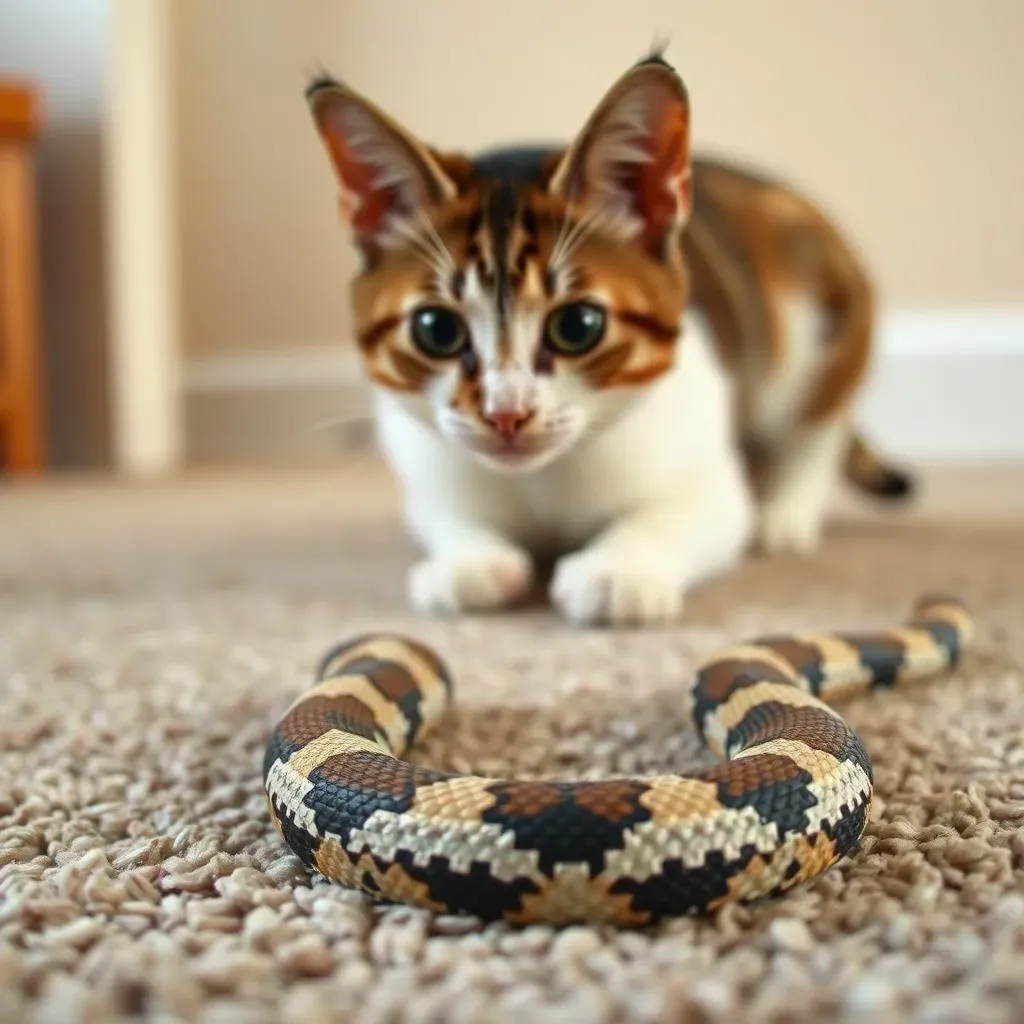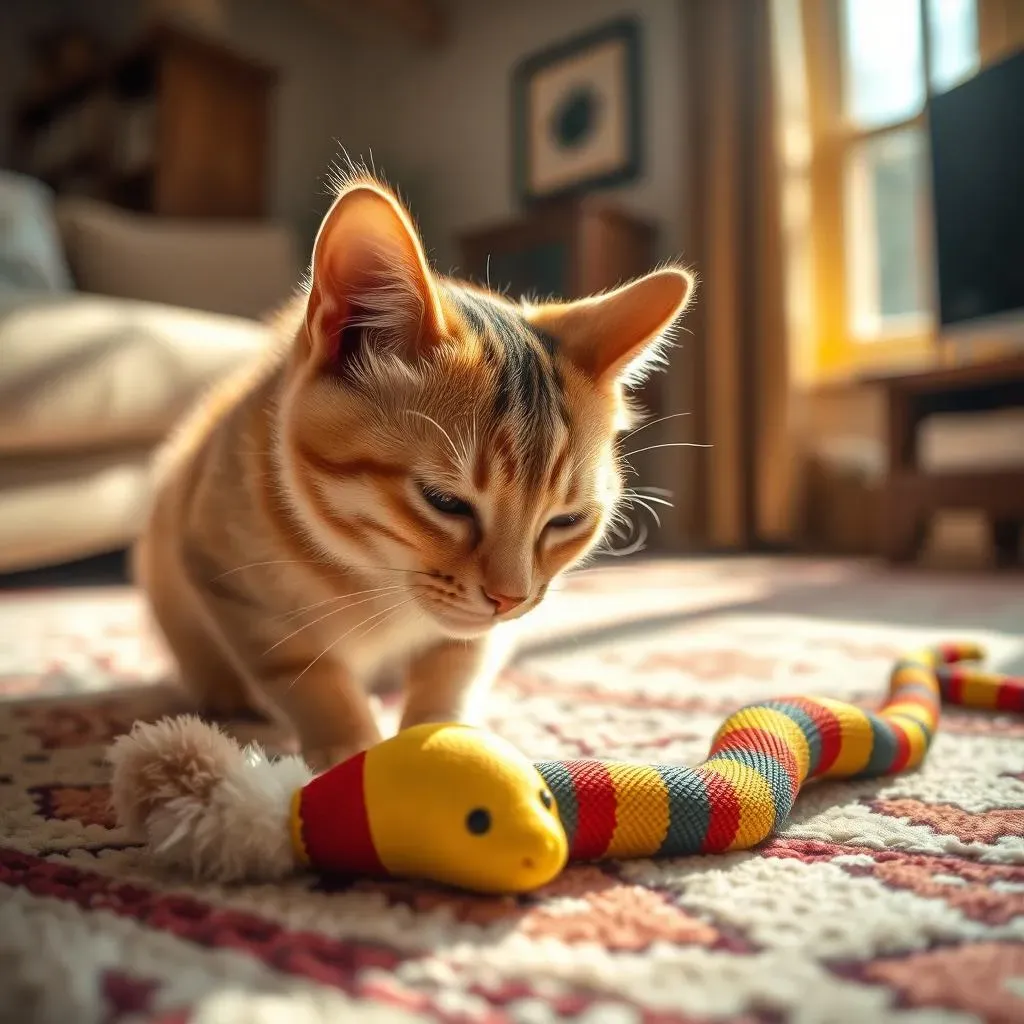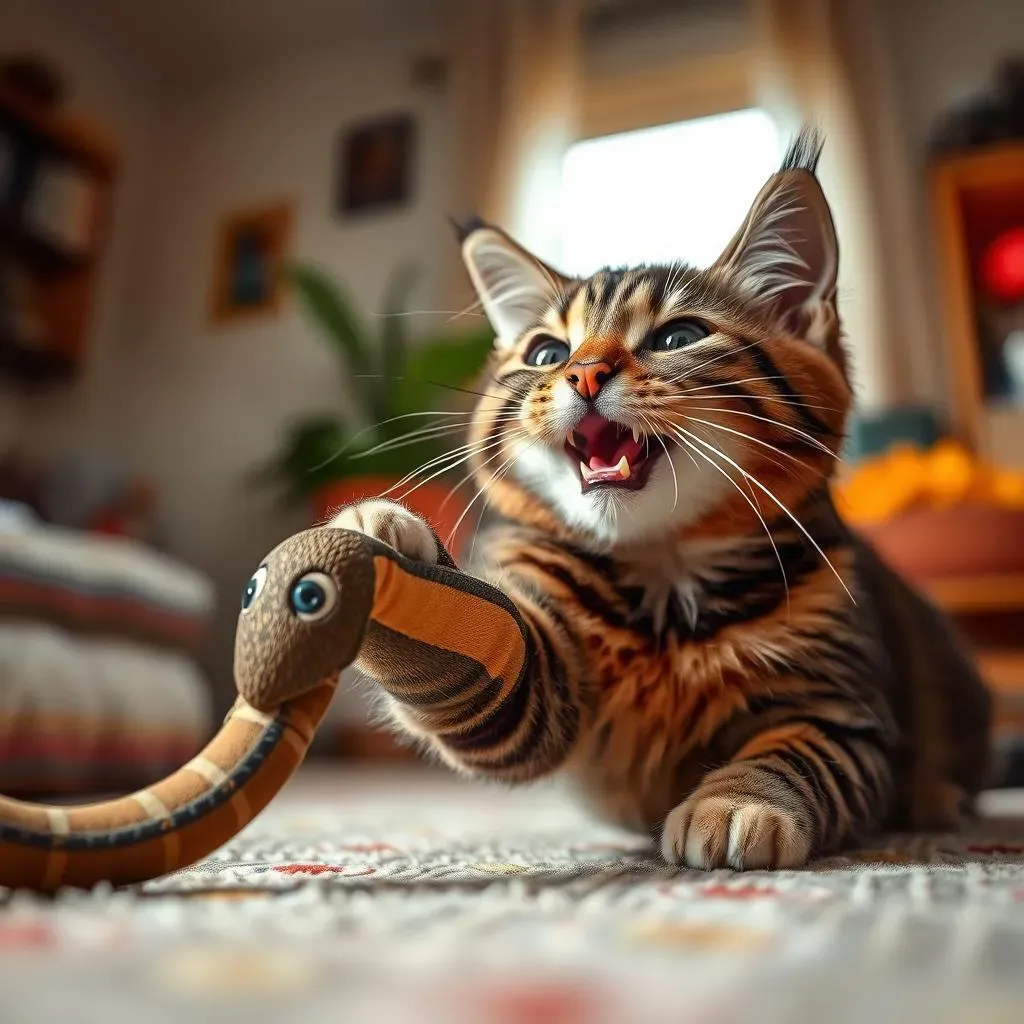Table of Contents
Ever watched your cat stalk a dust bunny like it's the most dangerous prey? Cats are natural hunters, and sometimes, a bored kitty can turn your ankles into their personal jungle gym. That's where the magic of a "cat toy moving snake" comes in. These aren't your garden-variety playthings, they mimic the slithering, unpredictable movements of real snakes, tapping into your cat's primal instincts. This article will guide you through the exciting world of these toys. We’ll explore why they're so captivating for cats, how to choose the best one for your furry pal, and how to introduce it to them safely. We'll even tackle common problems and how to keep the fun going. Think of this as your ultimate guide to all things "cat toy moving snake," ensuring your feline friend stays entertained and engaged, and your ankles remain safe from surprise attacks.
Why a Moving Snake Cat Toy?

Why a Moving Snake Cat Toy?
The Hunter's Instinct
Let's face it, our cats are tiny, domesticated versions of wild predators. They still have that deep-seated urge to hunt, stalk, and pounce. A moving snake cat toy taps right into that. It’s not just a random object; it’s a simulation of prey. The snake's slithering motion triggers their chase response, giving them a chance to exercise their natural hunting behaviors without, you know, actually hunting anything. This is great, because it can prevent them from redirecting their hunting to your feet at 3 AM.
My cat, Mittens, is a prime example. She’s the sweetest little fluffball, but put a moving toy in front of her, and she turns into a miniature tiger. It's fascinating to watch her focus and the little wiggle she does before she strikes. It's like she's starring in her own nature documentary.
Combatting Boredom
Indoor cats, bless their little hearts, often don’t get the mental and physical stimulation they need. This can lead to boredom, which, in turn, can lead to destructive behaviors like scratching furniture or excessive meowing. A moving snake cat toy offers a fantastic way to keep them entertained. It's unpredictable, which keeps them engaged longer than your average string toy. The movement and the challenge of catching it provides a good mental workout, too.
The Exercise Factor
Beyond just entertainment, a moving snake cat toy can be a great way to get your cat moving. Obesity is a real issue for many indoor cats, and chasing a toy like this can provide much-needed exercise. It’s a fun and engaging way to encourage them to burn some energy. Plus, it's way more fun than just staring out the window. Think of it as your cat's personal workout buddy, without any of the motivational speeches.
It's a win-win situation: your cat gets to be a hunter, they get some exercise, and you get some peace and quiet.
Benefit | Description |
|---|---|
Satisfies Hunting Instincts | Taps into their natural urge to hunt and stalk prey. |
Combats Boredom | Provides mental stimulation and prevents destructive behaviors. |
Encourages Exercise | Helps cats stay active and maintain a healthy weight. |
Choosing the Right Moving Snake Cat Toy

Choosing the Right Moving Snake Cat Toy
Okay, so you're convinced a moving snake cat toy is the way to go, which is great! But not all snake toys are created equal. It's like trying to choose the perfect avocado – you want something that's just right, not too hard or too squishy. First things first, think about the size of your cat. If you have a tiny kitten, a huge, intimidating snake toy might scare them more than entertain them. Conversely, a giant Maine Coon might just swat a small snake toy into oblivion and then look at you like, "Is that all you've got?". You want a toy that's proportional to their size, so they can actually interact with it comfortably. Also, consider the material. You want something that’s durable enough to withstand those intense play sessions, but also safe for your cat to chew on. Avoid anything with small, easily detachable parts that could be a choking hazard.
Next up, let's talk about movement. Some snake toys just wiggle back and forth, while others have more realistic, serpentine motions. The more realistic the movement, the more likely it is to capture your cat’s attention, but you also don't want it to move so fast that your cat gets frustrated. Also, think about the type of surface your cat will be playing on. If you have mostly carpeted floors, you'll need a snake toy that’s designed to move well on that surface. Some toys are better suited for hard floors. Battery life is another key factor. You don't want to be constantly swapping out batteries, so look for a toy with a decent lifespan or a rechargeable option.
I remember one time, I bought a snake toy that looked amazing online, but it barely moved on my carpet. My cat just stared at it like, "Seriously? Is that it?". So, lesson learned – always check the details and consider your cat's environment. It's all about finding that perfect balance of size, material, movement, and practicality.
Factor | Consideration |
|---|---|
Size | Proportional to your cat's size. |
Material | Durable and safe for chewing. |
Movement | Realistic and suitable for your cat's play style. |
Surface | Works well on your floor type. |
Battery | Long-lasting or rechargeable. |
How to Introduce the Moving Snake Toy to Your Cat

How to Introduce the Moving Snake Toy to Your Cat
First Impressions Matter
Okay, so you've got your new snake toy, ready to unleash the fun. But hold your horses! Don't just switch it on and throw it at your cat. That’s a recipe for a scaredy-cat situation. Instead, start by letting your cat sniff and investigate the toy while it's turned off. Place it near them, let them get acquainted. Think of it as a first date, you wouldn't just jump right in, would you? Let them explore it at their own pace. This allows them to get used to the smell and texture, without the added surprise of movement. It's all about creating a positive association from the get-go.
I once made the mistake of just switching on a very loud toy near my cat, she bolted and hid for hours, and it took a while for her to even look at it again. So, trust me, slow and steady wins the race here. It's better to be patient and let them approach the toy on their terms. You want them to see it as a fun playmate, not a scary monster.
Gradual Introduction to Movement
Once your cat seems comfortable with the static toy, it's time to introduce the movement. Start with short bursts. Turn the toy on for a few seconds, then turn it off. See how your cat reacts. If they seem curious and engaged, great! If they seem unsure or scared, then stop and try again later. The key is to keep the interactions positive. You don't want them to associate the moving toy with fear or anxiety. If they are enjoying it, you can slowly increase the duration of the play sessions and the level of movement. You can also try moving the toy around yourself, which will give you a better control over the interaction with your cat.
Think of it like teaching someone to swim. You wouldn't just throw them into the deep end, would you? You'd start in the shallow end, letting them get used to the water. It's the same with the snake toy. You want to gradually introduce the movement, allowing your cat to build confidence and enjoy the experience. You can also try using a wand toy to engage your cat while the snake toy is moving, which can help them to focus on the movement and have more fun.
Step | Action | Purpose |
|---|---|---|
1 | Present the static toy | Allow your cat to investigate and get comfortable with the smell and texture. |
2 | Introduce short bursts of movement | Gauge your cat's reaction and avoid overwhelming them. |
3 | Gradually increase play time and movement | Build their confidence and enjoyment. |
Troubleshooting and Safety Tips for Moving Snake Cat Toys

Troubleshooting and Safety Tips for Moving Snake Cat Toys
Common Issues and How to Fix Them
Alright, let's talk about when things don't go as planned. Sometimes, despite our best efforts, our feline overlords decide they're not impressed. One of the most common issues is that the toy stops working or doesn't move correctly. First things first, check the batteries. It might seem obvious, but a surprising amount of frustration can be solved by simply swapping in fresh ones. If that doesn't work, make sure there are no hair or debris tangled around the wheels or moving parts. Sometimes a quick clean-up is all it takes to get things moving again. Another issue is that the toy might be too loud or too fast. If your cat seems scared or uninterested, try adjusting the speed settings or switching to a quieter mode, if your toy has those options. It's all about finding the right balance of fun and comfort for your cat.
I remember when my cat, Leo, decided he was done with his snake toy. It just stopped moving, and I was convinced it was broken. I was about to toss it when I decided to check it one last time. Turns out a massive hairball was wrapped around the wheel, talk about a buzzkill. So, before you throw in the towel, do a little detective work. A little maintenance can go a long way. Also, if your cat seems bored, try changing the play environment. Maybe move it to a different room or a different type of floor. A change of scenery can sometimes reignite their interest. It’s like giving the toy a new personality, even though it’s the same old snake.
Safety First: Keeping Your Cat Safe
Now, let's talk safety, because this is seriously important. While these toys are designed for fun, it’s important to make sure your cat is playing safely. Always supervise your cat while they're playing with the snake toy. This way, you can intervene if they start chewing on it or if a small part comes loose. Even though most of these toys are made from durable materials, cats are masters of destruction. Always check the toy regularly for any damage or wear and tear. If you see any cracks, broken pieces, or loose parts, it's time to replace it. It’s better to be safe than sorry. Also, make sure that the area where your cat is playing is free from any hazards. You don't want them to get tangled in cords or bump into anything dangerous while they're chasing the snake.
I know, I know, I sound like your mom, but trust me, a little bit of precaution goes a long way. I once had a scare when my cat started chewing on the battery compartment of a toy. Luckily, I was watching, and I was able to take it away before anything happened. So, always be vigilant, and don't leave your cat unattended with the toy. Also, make sure the toy is stored away when not in use. This will prevent your cat from getting to it when you're not around. It’s also a good way to keep the toy “fresh” and exciting for when it's playtime. Think of it like a special treat that only comes out at certain times. It’s all about creating a safe and fun environment for your feline friend.
Issue | Solution |
|---|---|
Toy not moving | Check/replace batteries, clean moving parts |
Toy is too loud/fast | Adjust settings, use quieter mode |
Cat is bored | Change play environment, introduce new toys |
Safety Rule | Action |
Supervision | Always supervise your cat during play |
Regular Checks | Inspect toy for damage or wear |
Safe Area | Keep play area hazard-free |